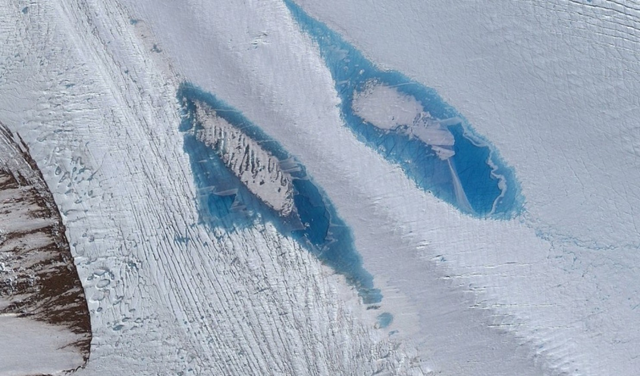Dazzling blue lakes are forming in Antarctica, and scientists are worried
[Jim Hansen’s supralinear sea level rise scenario looks increasingly likely. –Des] By Chris Mooney
17 August 2016 (Washington Post) – In a new study, scientists who study the largest ice mass on Earth — East Antarctica — have found that it is showing a surprising feature reminiscent of the fastest melting one: Greenland. More specifically, the satellite-based study found that atop the coastal Langhovde Glacier in East Antarctica’s Dronning Maud Land, large numbers of “supraglacial” or meltwater lakes have been forming — nearly 8,000 of them in summer between the year 2000 and 2013. Moreover, in some cases, just as in Greenland, these lakes appear to have then been draining down into the floating parts of the glacier, potentially weakening it and making it more likely to fracture and break apart. This is the first time that such a drainage phenomenon has been observed in East Antarctica, the researchers say — though it was previously spotted on the warmer Antarctic Peninsula and was likely part of what drove spectacular events there like the shattering of the Larsen B ice shelf in 2002. When it comes to East Antarctica, however, “that’s the part of the continent where people have for quite a long time assumed that it’s relatively stable, there’s not a huge amount of change, it’s very, very cold, and so, it’s only very recently that the first supraglacial lakes, on top of the ice, were identified,” said Stewart Jamieson, a glaciologist at Durham University in the U.K. and one of the study’s authors. The study was led by Emily Langley of Durham, who worked along with Jamieson and Chris Stokes from her university and Amber Leeson of Lancaster University. The work was recently published online by Geophysical Research Letters. The research raises concern, for the following reason: Mounting evidence suggests one reason that Greenland has been melting so fast lately is precisely these kinds of lakes. In the summer as air temperatures warm, lakes form on top of the ice sheet, and on its finger-like glaciers that extend outwards into deep ocean fjords. These lakes can then suddenly disappear all at once, or flow into rivers that drain into the ice below, lubricating the ice and helping to increase the lurch forward of glaciers. Sometimes, researchers have even been able to document fresh water flowing outward directly into the sea from the base of a glacier. That injection of cold fresh water into salty water can then create tornado-like underwater flow patterns at the submerged glacier front that cause further ice loss. [more]
Dazzling blue lakes are forming in Antarctica — and they’ve got scientists worried 
ABSTRACT: Supraglacial lakes are known to influence ice melt and ice flow on the Greenland ice sheet and potentially cause ice shelf disintegration on the Antarctic Peninsula. In East Antarctica, however, our understanding of their behaviour and impact is more limited. Using >150 optical satellite images and meteorological records from 2000-2013, we provide the first multi-year analysis of lake evolution on Langhovde Glacier, Dronning Maud Land (69°11’S, 39°32’E). We observe 7,990 lakes and 855 surface channels up to 18.1 km inland (~ 670 m a.s.l.) from the grounding line, and document three pathways of lake demise: (i) refreezing, (ii) drainage to the en-/sub-glacial environment (on the floating ice), and (iii) overflow into surface channels (on both the floating and grounded ice). The parallels between these mechanisms, and those observed on Greenland/the Antarctic Peninsula, suggest that lakes may similarly affect rates and patterns of ice melt, ice flow and ice shelf disintegration in East Antarctica.
Seasonal Evolution of Supraglacial Lakes on an East Antarctic Outlet Glacier
